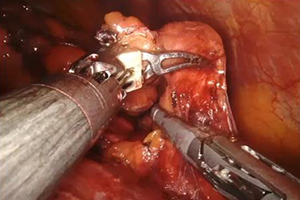Biportal robotic surgery for anterior mediastinal mass
Abstract
Background: Robotic-assisted surgery for mediastinal disease has been shown to be beneficial in facilitating easier mediastinal dissection with its three-dimensional views and multi-articulated moving instruments. Herein, we report our experience with the biportal approach of robot-assisted anterior mediastinal mass surgery, including both lateral transthoracic and subxiphoid approaches.
Methods: We retrospectively analyzed 21 patients who underwent biportal robotic-assisted anterior mediastinal mass resection, without considering the tumor size between May 2018 and September 2022. We reviewed the technical advantages and limitations of the biportal approach and the perioperative outcomes, including operative time, conversion to multiport or open surgery, duration of chest drainage, and postoperative complications, to define the role of robot-assisted surgery using the biportal approach.
Results: We approached the thoracic cavity from the right side in five patients, from the left side in three patients, and from the subxiphoid in 13 patients. Thymomas (n=13) and thymic cysts (n=3) were the most common diagnoses. The median operative time was 165 min [interquartile range (IQR), 140–196 min].
There were no conversions to multiport or open surgery. The chest drain was removed at a median of two days (IQR, 1–3 days), and the patients were discharged at a median of four days (IQR, 3–5 days). Perioperative complications were reported in two patients (one with prolonged air leak and one with vocal cord palsy). There were no cases of readmission or delayed complication.
Conclusions: The biportal approach for robot-assisted surgery in anterior mediastinal masses is a feasible and safe alternative for treating associated pathologies. The subxiphoid approach for mediastinal surgery provides a better surgical view than the transthoracic approach. The biportal approach also enables the use of robotic staplers and energy devices and minimizes instrumental interference compared to that in the single-port approach.
Cover






